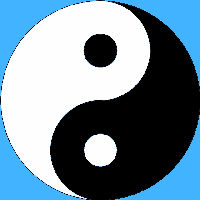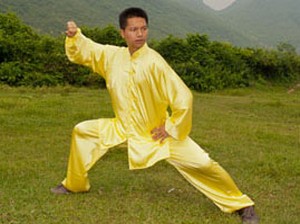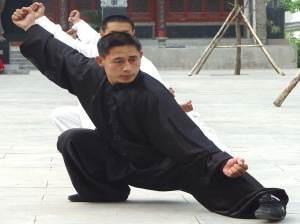An Introduction to Tai Chi & The Internal Martial Arts of China
The Martial Art Traditions in China have evolved into an amazing diversity of sophisticated art forms over the last thousand years.
They are divided into two basic groups :
1) Those using Internal Energy or Qi as the primary source of power for movement.
2) Those using External Energy i.e. muscle power.
The purpose of this website is to promote the Internal Martial Arts.
Of these Tai Chi is the most widespread and as such is the foundation of this website, though I hope to include more on the other arts in the future.
What is Tai Chi Chuan?
- A Connected Meditation - eyes open, body active, mind connected with the external world yet still and quiet.
- An Amazing Healthcare System.
- The Ultimate Martial Art.
- Beauty in Movement.
- A Great Way to Start the Day.
Tai Chi is all of these things, although different teachers may focus more or less on the various aspects in their own practice and teaching.
History
Tai Chi Chuan is one of the products of the Taoist Spiritual Tradition and Chinese Martial Art Culture with roots dating back far into the past.
There are five main styles in existence today :
- Chen Style created by Chen Wang Ting (1580-1660)
- Yang Style originating from Chen - Yang Lu Chan (1799-1872)
- Wu (Hao) Style from Yang & Chen - Wu Yu-hsiang (1812-1880)
- Wu Style (Small Circle) from Yang - Wu Chuan Yau (1834-1902)
- Sun Style from Yang, Wu(Hao), Xinyi & Bagua - Sun Lutang (1861-1932)
There are differing opinions as to the historical foundations of Tai Chi but it seems likely that Chen Tai Chi was the original Tai Chi.
Other theories favour Zhang San Feng and Wudang Kungfu but there is no historical evidence for this.
Either way, Tai Chi was influenced by and inherited aspects of the Taoist internal energy tradition which existed much earlier and no doubt also included aspects of body movement.
Chen Wang Ting, by combining his knowledge of the Yin / Yang, Chinese Medicine Qi theory, 'Tu Na' (Exchanging Dirty Qi for Clean Qi) and Internal Qi Gong with the Chen family Kungfu, was able to create a new martial art form - Tai Chi Chuan.
Yang Style Tai Chi was originally created by Yang Lu Chan. Traditionally Chen Tai Chi was only passed on to family members but Yang Lu Chan worked as a servant for Chen Chang Xing and eventually received teaching from him. Yang Lu Chan later had contact with other martial arts including Baguazhang and his own personal style evolved forming the framework for Yang Tai Chi.
Wu (Hao), Wu (Small Circle) & Sun Tai Chi were created by exceptionally high level practitioners whose personal styles evolved unique qualities which differentiated them from Yang Lu Chan's form. They are much less widespread than Yang Style but this in no way implies that they are not worth learning if you can find a good teacher. In fact the opposite may well be true, these styles were re-influenced by Chen Xiao Jia, the small circle Chen form and may well be superior to most Yang style Tai Chi now available.
Ultimately the style of Tai Chi practised is not important, all good Tai Chi follows the internal energy movement and is the same. What is important is the quality of the Tai Chi.
High Level Tai Chi Chuan
Tai Chi Chuan is an Internal Martial Art system which places emphasis on the development and control of Qi within the body.
This is achieved with the aid of the Tai Chi Forms, sequences of movement practised in a meditative state of mind.
Practiced at the highest level, Qi enters the body through the feet and rises up to the 'dan tian' or abdominal area.
Movement orginates with subtle changes in the centre of gravity of the practitioner.
This may sometimes be imperceptible to the casual observer, but for the practitioner it generates a strong feeling of Qi moving in the body. The shifting weight causes the 'Dan Tian' to twist and turn which then moves the rest of the body around it in relaxed, circles and spirals without the use of muscular assistance.
The highest level practitioner learns not to force the movement either with conventional muscle action or with consciously controlled power from the abdominal dantian. Instead the movement comes naturally by itself powered by the soft Qi rising up through the feet. The feeling is gentle and comfortable. In the beginning it is weak but as the body becomes more sung, it becomes very strong, in a quiet way. The Tai Chi simply happens and you watch.
Postures alternate between Yin ones with the Qi resting in the dantian and Yang ones with the Qi out at the extremeties. This alternation recharges the energy and keeps it moving.
The Tai Chi forms themselves are connected sequences of dantian Qi spirals, which one simply connects to inside oneself and consciously surrender to. The actual shape of the form that manifests moment by moment is a spontaneous creation of the body built around the template of the learnt form and doesn't feel stale when done well.
Over time the high level practitioner's body may introduce it's own small circles on to the learnt form and this is natural, but the basic forms themselves have been created by the 'sung' bodies of some of the highest masters of the martial arts and feel satisfying in themselves.
In the beginning only the main dantian in the abdominal region is active, but as the level of the practitioner develops, every part of the body starts to form energy spirals which bring greater and greater subtlety to the movement and so one develops. The body itself starts to change, becoming soft, yet strong, like water.
Achieving this high level requires an amazing ability to relax deeply the mind, body and heart - energy channels fully open and flowing with Qi.
In Tai Chi, this state of relaxation is called 'fang sung' and can best be described as a combination of relaxation, alertness, poise and balance.
A state of being, totally in the 'Now' in body and mind.
If you were holding a glass, the tension in your body would be such that the slightest further relaxation would cause the glass to drop.
If you were to think of yourself as a glass with water in it, surrounded by an ocean. Forget the glass and become the ocean.
Committed practice teaches the practitioner to surrender to the Tao that can guide one between the yin and the yang in the truth of the moment.
This could be called natural movement, it is spontaneous and unaffected without conceptual 'faking' and the feeling when this happens deeply is extraordinary.
Tai Chi can be a spiritual perfection path of the highest order for those who wish to reach for the Ultimate in their life.






